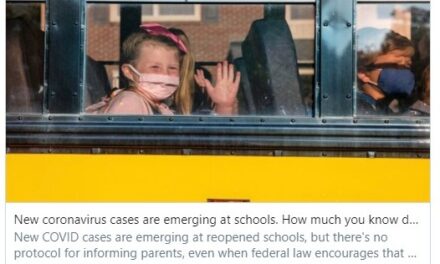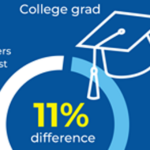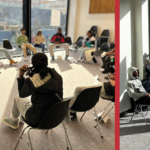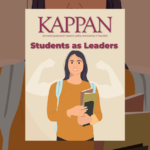Collected wisdom from folks at the Hechinger Report, The 74, Chalkbeat, EdFund, the Edunomics Lab, and Education Resource Strategies.
By Alexander Russo
The big pile of federal funding that Congress sent to schools during the pandemic is winding down, and many districts are having to make tough budget decisions.
Known as ESSER (for Elementary and Secondary School Emergency Relief fund), the additional $190 billion in federal funding was sent to schools to help them deal with the COVID pandemic, with relatively few strings attached compared to other federal funding streams.
However, the funds have to be spent within the next year, and schools are already struggling to figure out how to make the transition without falling over the much-discussed school funding cliff. Declining enrollments due to birth rates, school choice, and even homeschooling are playing a part in school budget changes and possible school closings.
How can school funding cliff stories be covered in ways that are helpful and accurate? It’s easy to write a “sky is falling” story that will alarm readers and overstate the federal role, compared to state and local funding. It’s also easy to write a story that’s so full of bureaucratic budget-ese that nobody wants to read it. So we asked journalists and experts what to do — and what not to do.
Their advice? Master the basics. Give readers context rather than raw numbers. Don’t forget enrollment declines and other structural dynamics that have nothing to do with ESSER. Look out for budget cuts with disproportionate effects (on students or educators). And focus on homeless kids and lunch menus rather than HVAC systems.
Give readers context rather than raw numbers. Don’t forget enrollment declines. Look out for budget cuts with disproportionate effects.
THE BASICS
KNOW WHAT TO CALL IT
“It was extra, emergency bonus money that doubled the amount of federal funds that schools usually receive,” says the Hechinger Report’s Jill Barshay. “For many school systems, it enabled spending to increase by $5,000 per student. It is a lot of money.”
CHECK YOUR NUMBERS
“Get your numbers straight!” says Chalkbeat Chicago’s Reema Amin. “Make sure to check the budget documents, ask the district to confirm, and call principals/central office sources to gut check those numbers, as well as budget watchdogs if you can.”
REMEMBER KEY DATES
“Sept. 30, 2024, is the deadline for spending federal pandemic recovery funds on direct salary payments to teachers and staff and signing contracts with outside vendors,” notes Barshay. “But schools can continue to pay outside vendors for services rendered through March 28, 2026.” This means a school can sign a new contract with a tutoring nonprofit as late as Sept. 30 and have them continue teaching kids through most of the 2025-26 school year.”

Above: Barshay, Amin, and Roza
SIMPLE IS GOOD
USE UNDERSTANDABLE NUMBERS
“Include real financials, preferably in per pupil terms since readers can’t make sense of dollars in the millions,” says the Edunomics Lab’s Marguerite Roza. For example, “the district has $14,881 to spend per student, and the current gap means cutting $502 per student.”
DEPICT REAL PEOPLE & RESULTS
“Always include real people being affected by the cuts,” says Chalkbeat’s Amin. “Numbers are an important element of a story, but they don’t mean much if you can’t show how the cuts will affect students and schools.”
“Don’t lose track of student outcomes,” agrees Roza. “A financial story isn’t just about the amounts of money, but also the extent to which money is delivering outcomes for students.” She recommends the Stanford education opportunity site as a great way to check in on how the academic recovery is going.
DITCH ACRONYMS
“Try to write the story without the acronym ESSER,” says Barshay. “I like to call this bucket of money — $190 billion — ‘pandemic recovery funds from the federal government.’”
CONTEXT MATTERS
GIVE PERCENTAGES VS. RAW NUMBERS
“If a district is laying off staff, don’t just report the raw numbers,” says independent school finance analyst Chad Aldeman. “Instead, put them in percentage terms as a share of the district’s entire workforce — or better yet, in context of that specific role (e.g. teachers or paraprofessionals). Similarly, how do the new numbers compare to pre-pandemic numbers? School districts are often large employers, so these types of comparisons will help readers understand any staffing changes.
DIFFERENTIATE NEW JOBS VS. OLD ONES
“If your district is laying off teachers, ask how many positions were recently added,” advises Barshay. “Some of the layoffs may be shedding brand new jobs that were financed through the $190 billion in federal pandemic recovery funds that are expiring. Compare staff counts after the layoffs with pre-pandemic numbers: 2024 v. 2019. (Imagine winning the lottery and hiring a large household staff. Those butlers and nannies may need to go when all the lottery money is gone.)”
FOCUS ON KID EFFECTS/BENEFITS
“Keep coverage focused on kids as much as possible,” advises Aldeman, who is also a columnist for The 74. “If a district made some investment that is now winding down, how well did it work? How do district leaders know, or what evidence can they point to? This isn’t just a ‘gotcha’ exercise; the public needs to understand the benefits of any programs in order to evaluate whether they deserve continued support.”

Above: Aldeman, Sibilia, and Hawkins
ENROLLMENT DECLINES!
DIFFERENTIATE FROM DECLINING ENROLLMENT
“I actually think that the ‘funding cliff’ is going to get conflated in the public discourse with the more sinister problem of declining enrollment,” says EdFund’s Rebecca Sibilia. “Reporters should be careful to tease out what they’re really seeing vs. what districts may be saying.”
DON’T FORGET STAFFING
“Take stock of whether some of the cliff is a result of enrollment losses,” says Roza. “How many fewer students does the district have? Do the reductions justify school closures?” According to Roza, 500-700 students is the size of a normal school. Staffing should roughly follow enrollment, and the Edunomics Lab’s site will produce relevant graphics. Whether closing schools saves money depends on a number of factors, according to Roza and others.
VULNERABLE KIDS & STAFF
SPOTLIGHT DIVERSITY
“How far into a district’s seniority rolls layoffs reach is an important story,” says The 74’s Beth Hawkins. But school systems invariably find themselves under pressure both to diversify and to ‘keep cuts away from the classroom’ by slashing administration. So Hawkins says a good question to ask is “whether there are — or were — staff who recruit diverse educators?” According to Hawkins, St. Paul Public Schools spent a sliver of its ESSER funding to create a very small staff that not only built relationships with HBCUs, Tribal Colleges, and teacher of color hiring events, but that also conducts retention interviews with early-career teachers of color to learn what would ensure that they stay in their jobs. “Are leaders thinking creatively about how to maintain this kind of effort? Intentional recruiting is a very big deal.”
IDENTIFY WHO’S MOST AFFECTED?
“Are low-income students bearing the brunt of the layoffs?” asks Barshay. “Compare how many teachers are being let go at the wealthiest school with the poorest school in your district.” Districts often let go of the most recently hired teachers first, according to union or district policies, and the most senior teachers get to keep their jobs. That’s a perk of being a veteran teacher. “But low-income schools tend to have more rookie teachers and they’ll be bearing the brunt of these policies with even more turnover. That’s not good for students.”
ASK ABOUT SMART CUTS
“If districts take a typical approach to budget cutting, which is to cut everything new and then hunker down and cut away at an already outmoded model of schooling, then we will lose an incredible opportunity to transform schooling,” says Education Resource Strategies CEO Karen Hawley Miles. “Reporters can help district leaders and the communities they lead move to more effective models by asking questions about which new areas of investment and practices are beginning to pay off for students… These new models may push against tradition, regulation, and contracts and will require community-wide support to implement at scale.”

Above: Miles, Belsha, and Elsen-Rooney
HOMELESS SERVICES, LUNCH MENUS, & HVAC SYSTEMS
WHAT ABOUT HOMELESS RELIEF?
“I would encourage reporters to dig into what it will mean for schools to lose a lesser-covered source of COVID relief funding specifically designated to support students experiencing homelessness known as the American Rescue Plan – Homeless Children and Youth funds,” urges Chalkbeat national education reporter Kalyn Belsha. “In some cases, this money dramatically expanded the role that schools are playing in families’ lives, and families have come to depend on that added support. Ask school districts how they spent their ARP-HCY money and to report what it will mean when that goes away.”
STOP KNEE-JERK COMPLAINING ABOUT HVAC & CAPITAL REPAIRS
“There’s been a lot of blowback on districts using ESSER for things like HVAC instead of ‘learning recovery,’” notes EdFund’s Sibilia. But it “turns out that HVAC and capital repairs actually lead to statistically significant increases in student achievement.”
GO WITH LUNCH MENUS?
“One tip for covering budget cuts: Check to see if there is any impact on school foods,” advises Chalkbeat’s Michael Elsen-Rooney, who, figuring that many parents tracked school lunch menus closely, obtained a list of the items being cut from the menu — and reported the elimination of popular but relatively expensive items like chicken dumplings and fries. “I heard from more families and educators on this story than anything I’ve worked on in a while.”
I
Thanks to journalists Reema Amin, Beth Hawkins, Michael Elsen-Rooney, Jill Barshay, and Kalyn Belsha, along with experts Marguerite Roza, Rebecca Sibilia, Karen Hawley Miles, and Chad Aldeman for sharing their insights.
Previously from The Grade
Reporters share tips on covering immigrant education
Previous stories about covering budget issues:
Messy times ahead for school spending
How to cover schools’ COVID recovery spending
The scarcity mindset that plagues education news
Smart ways to cover the coming ‘year of ed finance’
Covering school closures
Closings are coming. Cover them well. (Tim Daly)
The closer (Jill Tucker interview)
‘Make all the lemonade’ (Lauren FitzPatrick)













